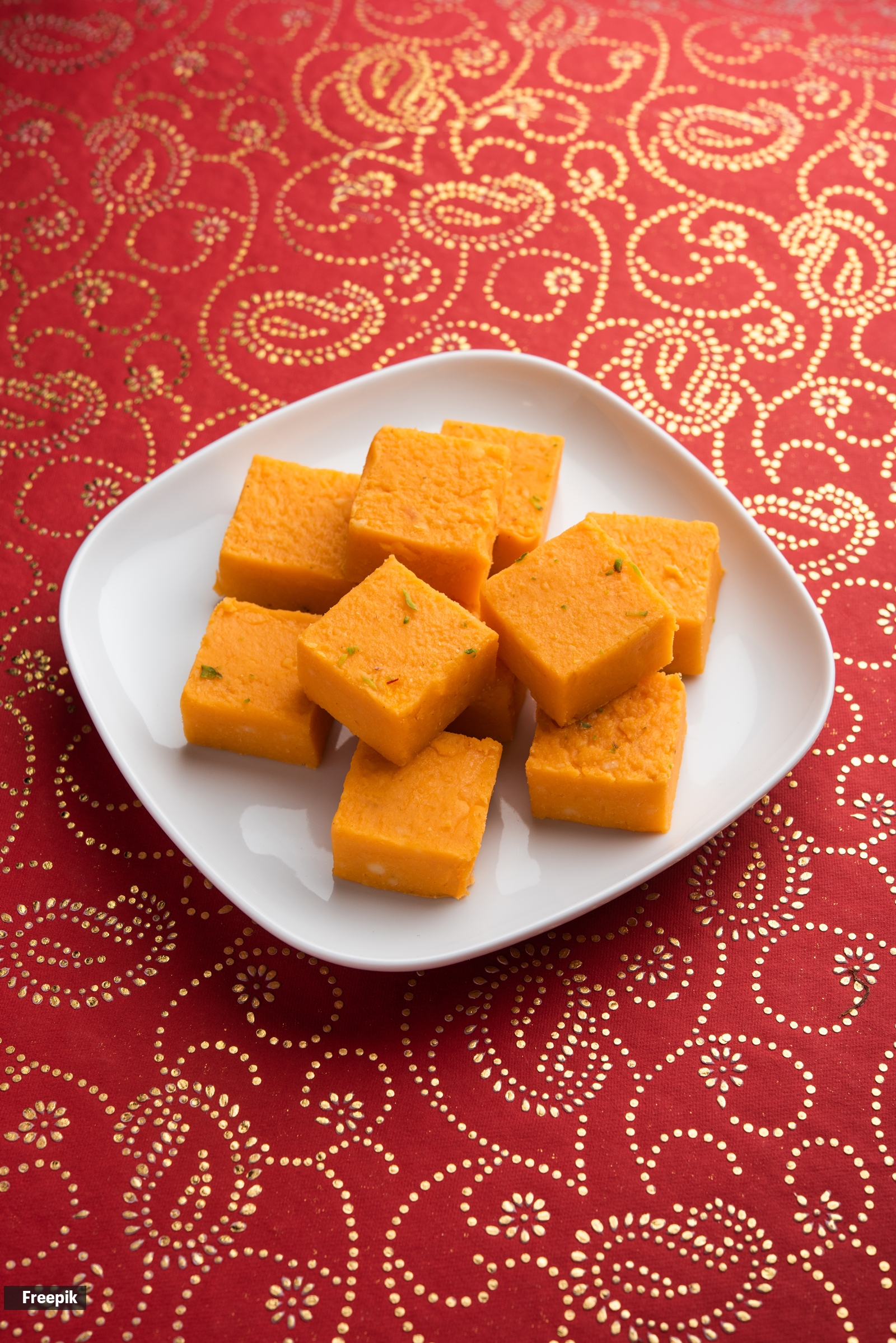📣 For more lifestyle news, click here to join our WhatsApp Channel and also follow us on Instagram
Barfi unwrapped: From Persia to Punjab, the journey and appeal of these diamond-shaped delights
There are very few sweets that can boast history as rich as barfi.
 Almost all references to kaju katli, as kaju barfi is commonly called, show that it originated in western India. (Photo: Freepik)
Almost all references to kaju katli, as kaju barfi is commonly called, show that it originated in western India. (Photo: Freepik)At celebrations or community festivals, you can bet your last paisa that a piece of barfi will find its way onto your plate, especially if you live in northern or western India. Come Diwali, it’s almost impossible to find a home without at least one box of kaju barfi.
Made from condensed milk, ghee, and sugar, barfi is cooked into a smooth paste, set to cool, and then cut into diamond or square pieces, often adorned with varq, or edible silver leaf. Fudge-like in texture and less sweet than many Indian confections, there are many reasons why barfi is a popular dessert. The sweet was supposedly named after the Persian and Urdu word baraf, which means snow because when these diamond-shaped sweets are stacked together, they resemble snowy white peaks. I’ve never found any written documentation of this.
Barfi is resilient—it withstands the heat of North India and the humidity of the West, and if stored in an airtight container, barfi can retain its texture and flavour for months. This makes it an ideal gift, and is one reason for its popularity.
Like fudge, barfi comes in a variety of flavours. From chocolate, rosewater, and cardamom the flavours range to pistachio and even fruity options like orange, mango, and strawberry. The iconic kaju barfi––popular and expensive––made with ground cashews, has a smooth, ivory hue, while pista barfi, crafted from pistachios, has a vibrant green colour. Each ingredient contributes to its distinctive appearance, with sugar binding it together.
Very few sweets can boast history as rich as barfi. While it gained pan-Indian popularity during the Independence movement, you can trace its origins to the Sikhs and ultimately, the Persians. No matter its historical provenance, barfi’s form continues to signify a morsel of slow-cooked sugary goodness.
One story connects kaju barfi to the Mughal era during Jehangir’s reign, who imprisoned Guru Hargobind, the sixth Sikh guru in the Gwalior Fort. When Jehangir announced the Guru’s release, he decreed that any prisoner holding onto his robe as he exited could also gain freedom. In response, Guru Hargobind had a robe made long enough for every prisoner, symbolically freeing them all on Diwali. This is now celebrated as Bandhi Chhor Diwas by the Sikhs. In gratitude, Jehangir’s royal chef prepared kaju barfi.
Almost all references to kaju katli, as kaju barfi is commonly called, show that it originated in western India. The most authentic version of this sweet can be found in cities like Mumbai, Ahmedabad, and Surat.
 Like fudge, barfi comes in a variety of flavours. From chocolate, rosewater, and cardamom the flavours range to pistachio and even fruity options like orange, mango, and strawberry.
Like fudge, barfi comes in a variety of flavours. From chocolate, rosewater, and cardamom the flavours range to pistachio and even fruity options like orange, mango, and strawberry.
Another extremely popular variety of barfi is dhoda barfi––which originated in Pakistan as khushabi dhoda––and has a rich, grainy texture. Its origin can be traced back to Khushab, a city in Pakistan’s Punjab province. It’s one of those prized recipes that every shop in the region claims to have invented.
The Persian connection can be found here too. The word ‘Khushab’ is a combination of two Persian words, “khush” meaning sweet and “aab” meaning water; the name of the sweet deceptively referring to “sweet water”. According to local folklore, Persian invaders from the West first used this word to describe the waters of the Jhelum river, on the banks of which sat the historical city of Dhodha. Folklore has it that the dhoda barfi was supposedly invented by a local wrestler named Pehlwan Hans Raj in Khushab in 1902. He wanted to create a snack to eat during his wrestling sessions which was dry, easy to cart around, and full of nutrients. There is no written proof of this, but it’s an urban legend often repeated. After Partition, when the family moved to Kotkapura, Punjab, India, they introduced the recipe to the local sweet makers.
The dhoda barfi can be bought in most parts of south Asia, packaged in air-tight boxes. It can also be made at home easily. The ingredients are easily procured: milk, sugar, broken wheat, clarified butter, dry fruits such as pistachios, walnuts, cashews, and even peanuts. The broken wheat needs to be soaked in milk till it absorbs all the milk and becomes grainy and thick. It is then cooked with sugar till it sticks together. The brown colour of the dhoda barfi comes from the slow cooking and is an indicator of it being cooked through. After cooling, it is transferred to a tray greased with ghee or clarified butter and flattened out. Slivered cashew nuts, pistachios, walnuts, and almonds are sprinkled on top. The barfi is then cut into squares.
In an earlier article, I’ve mentioned the genesis of the tiranga barfi — or the tricolour barfi — of Benaras, and how it was used to commemorate the unfurling of the flag on the banks of the Ravi river by Jawaharlal Nehru.
The Independence movement and the Partition led to many culinary creations in India. Some were to charm the Mughals, some to the British, some to celebrate victories, and others as offshoots of being forcibly evicted from their homelands. Every time you bite into a barfi, in a way, you’re biting into more than just slow-cooked broken wheat and sugar—it’s really a walk through India’s historical past.
KAJU BARFI
SERVES: 8
PREPARATION TIME: 30 mins
INGREDIENTS
Cashews 1 cup, chopped
White sugar ½ cup
Water ¼ cup, room-temperature
Cardamom powder a pinch, freshly ground
Ghee 1 tsp
METHOD
Grind the cashews to powder form.
In a hot frying pan, stir sugar with water. Set the flame to low and keep stirring until a sugar syrup forms. Add the ground cashews and mix well. Add the cardamom powder and continue to mix until the mixture becomes doughy. Add the ghee and stir until the ghee melts through the dough mixture. Take the pan off the stove.
Empty the mixture on your counter or in a bowl, grease your hands with ghee, and knead until the dough is smooth. Form a ball with the dough and cover it with a slightly damp cloth. Take a baking tray, or a flat tray, and place a sheet of butter paper on it. Grease the butter paper with some ghee. Place the dough on the baking sheet and use a rolling pin to spread the dough flat. Keep the thickness to ¼ of an inch. Let this set in the fridge for an hour.
Cut the dough into diamond shapes with a sharp knife. Sprinkle with dried fruits, or varq, before serving.
Next week, since it’s party season and many of us will be spending time hosting – I’ll share some of my favourite kitchen hacks, from how to make an easy and quick mayonnaise to what to do if you add too much salt to the food and more…
📣 For more lifestyle news, click here to join our WhatsApp Channel and also follow us on Instagram
- 01
- 02
- 03
- 04
- 05




























